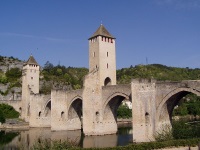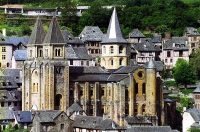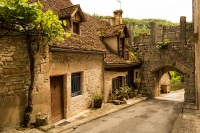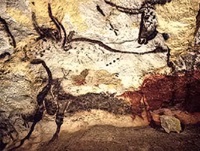Dordogne and Lot Travel Guide
The Dordogne (along with the neighbouring Lot Valley) is one of the most beautiful regions in France; a magnetic holiday destination for food lovers and nature enthusiasts. The area has remained fairly untouched by 20th-century development and tourism and the rural way of life continues very much as it has for centuries. Local farmers seem happy to live a fairly subsistence lifestyle, and village markets continue to flourish here long after they have disappeared from the high streets of other European countries. This is owed, no doubt, to the local taste for fresh ingredients and the disregard for what are seen as draconian EU health and safety laws.
Dordogne is home to more than 1,500 castles and 150 prehistoric sites. There is a popular museum of medieval warfare at the Chȃteau de Castelnaud in Castelnaud-La Chapelle, and the stone villages of Rocamadour, Domme and La Roque Gageac give visitors the feeling of having stepped into a time machine.
Although medieval villages and towns such as Conques, Cahors and Montauban are starting to be discovered by tourists looking for a more authentic France, they have managed to retain their old-world charm. Visitors don't come here for a busy nightlife, or indeed for the weather (which can be wet even in summer). They are drawn instead to the stunning countryside, pâté, truffles, succulent Limousin veal and fine wine.
Things to do in Dordogne and Lot
Attractions in Dordogne and Lot revolve mainly around the area's many lovely and historic villages. The medieval towns of Cohors, Conques and Montauban are remarkable and the stone villages of Domme and La Roque Gageac will captivate all who set foot in them. The most spectacular, however, is Rocamadour, which has been a pilgrimage site since the 8th century and has possibly the most breathtaking setting of any town in Europe. This cliffside town is fascinating and is one of the region's greatest treasures.
Visitors can easily do a tour of Dordogne and Lot centred only on châteaux, as there are so many exciting castles scattered about. Some of the best are the Château de Castelnaud, which houses a wonderful museum of medieval warfare; the Château de Commarque, a ruined 12th-century chateau with caves containing evidence of prehistoric man; and the Château de Beynac, an impressive castle perched above the restored medieval town of Beynac and commanding beautiful views over the river. The Château de Marqueyssac pales in comparison to these fortresses but has gorgeous gardens and cliffside walks.
Dordogne is one of the richest areas in the world in terms of ancient sites and evidence of prehistoric man. The famous painted caves of Lascaux are regrettably no longer open to the public, but there are equally impressive sites to explore, including the incredible Cave of Font-de-Gaume, which is a UNESCO World Heritage Site.

Cahors
Situated 55 miles (89km) north of Toulouse, in a loop of the Lot River, the ancient city of Cahors was inhabited long before the Romans arrived, and in medieval times was a thriving university town. Across the river is the town's signature piece, the Pont Valentré. This magnificent fortified bridge was built between 1308 and 1500 and features a trio of towers, battlements and seven pointed arches. The Cathédrale St-Etienne dominates the old town and features a Romanesque north portal, which was carved around 1135.
Today the town is best known for its excellent cuisine and the fine deep red wine that is made in the surrounding vineyards. Sunday is market day and a good opportunity to buy some of the local produce. A good excursion from Cahors is the stunning cliff-edge village of St-Cirq-Lapopie, 19 miles (31km) to the east. Perched high above the south bank of the Lot, the village, with its cobbled lanes, half-timbered houses and gardens, is best visited in the evenings when the tour buses have left and the excellent restaurants have more tables available to linger over.
Montauban
Montauban lies on the banks of the River Tarn, 50 miles (80km) north of Toulouse, and is one of the most ancient cities in southwest France. Its origins date from 1144 when the Count of Toulouse decided to create a bastide here as a bulwark against English and French royal power. The genius of the original medieval town plan is still obvious in the lovely town centre and, although the suburbs now sprawl way beyond the old core, the city is still dominated by the fortified Eglise St-Jacques fort and the 14th-century brick bridge, Pont Vieux.
Montauban has a very attractive old town square and many of its buildings are constructed out of the red brick, typical for the region, which makes these old houses appear delightfully pink. The artist Jean-Auguste-Dominique Ingres (1780 to 1867) was born in Montauban and many of his works now hang in Musée Ingres, situated in the 17th-century Bishops Palace. The works collected here include the famous Dream of Ossian originally intended for Napoleon's bedroom in Rome. Apart from this art museum there are two religious monuments worth visiting in Montauban: the 13th-century Church of Saint Jacques; and the Cathedral of Notre-Dame, built in 1739 in the Baroque style.

Conques
Conques occupies a spectacular position on the flanks of the steep, densely wooded gorge of the little River Dourdou, a tributary of the Lot, and is one of the great villages of southwest France. The site was chosen as a retreat by a hermit called Dadon in the 7th century, and was named from the Latin concha, meaning shell.
Dadon founded a community of Benedictine monks here, one of whom pilfered the relics of the martyred girl, Ste Foy, from the monastery at Agen. Known for her ability to cure blindness and liberate captives, Ste Foy's presence brought pilgrims flocking to Conques and the magnificent Romanesque abbey-church became a prime stop on the pilgrimage route to Compostela in Spain.
Pilgrims still come today, along with tourists who come to admire Conques' beautiful setting. Conques is renowned to be one of the most beautiful villages in France and parts of the original town walls and gates survive, sealing in the narrow, cobbled village streets and the picturesque medieval houses spread out across the hillside. Conques Abbey was built between the 10th and 12th centuries, and the church and cloisters are truly impressive. The tympanum (carving above the main doorway) of the Last Judgement in the abbey is considered a masterpiece of 12th-century art.

Rocamadour
Tiered precariously halfway up a cliffside above a small river, Rocamadour has one of the most unique and breathtaking settings of any town in Europe. The town is famed for being the site where the body of Saint Amadour (who is believed to be Zacchaeus of the Bible) was discovered, an event that led to a succession of miracles in the town. Since the 8th century it has been an important pilgrimage site; everyone from prince to pauper has ventured here in the hope of curing their ailments at the shrine. Unfortunately, the famous reliquary of the shrine has been plundered several times so that today it bears little relation to the original; however, many still testify to the spiritual significance and healing power of the place.
Today the town is overrun by tourists and its atmosphere has suffered accordingly, but, despite this, it is a must-see for the stunning views of the Dordogne and its marvellous situation. The town has magnificent ancient architecture, with many of the buildings cut directly into the rock of the cliffs, and is gloriously picturesque. Balloon rides are a popular way to see the area. The seven sanctuaries that make up the pilgrimage site are truly wondrous to behold. Visitors shouldn't miss the famous Black Madonna, thought to have been carved in the 11th century, which can be found in the Chapelle Notre Dame, a small Gothic chapel built in 1479.

Les Eyzies
In 1868 prehistoric skeletons were discovered in the Vézère valley, and the area was found to be one of the richest in the world in terms of ancient sites and deposits. The small market town of Les Eyzies suddenly became the base for exploring this treasure-trove of antiquities, including the many prehistoric painted caves.
The most famous and beautiful of these sites is at Lascaux, discovered by accident in 1940 by boys looking for their dog. The paintings were made about 30,000 years ago and depict wild boar, deer and majestic bulls. Unfortunately visitors cannot view the actual paintings anymore because the caves have been closed to the general public to prevent deterioration, but a replica gives visitors a clear picture of the remarkable works.
Travellers can still enter the incredible Cave of Font-de-Gaume and see the original rock art in this UNESCO World Heritage Site. The town has some excellent museums in which prehistoric art and artefacts are on display. Be sure to visit the Chateau de Commarque, a truly remarkable site boasting the ruins of a 12th-century chateau and caves containing prehistoric artefacts and paintings.
Dordogne and Lot Climate and Weather
Dordogne experiences fairly mild winters and moderate summers, which can be long and very warm at times, making it the best time of year to visit Dordogne and Lot. Average summer daytime highs range from 77F to 95F (25C to 35C) with occasional storms and showers. Spring and autumn are mild with a higher chance of rain, while in late spring heavy rainfall can occur. Winters are generally mild with short periods of cold weather and with frequent rain. The region experiences variations in weather depending on the local area, due to the variable landscape, and things such as rainfall and temperature can vary from village to village, making conditions quite unpredictable. No matter what time of year one visits it is a good idea to take a rain jacket. Summer is peak tourism season but many visitors find the off-season pleasant in Dordogne and Lot.
France travel info
Electricity
The electrical current is 230 volts, 50Hz. European two-pin plugs are standard.
Language
French is the official language.
Money
The euro (EUR) is the official currency in France. Currency can be exchanged at banks, bureaux de change and some large hotels, though visitors will get a better exchange rate at the ATMs. Major credit cards are widely accepted, particularly in major tourist destinations. Foreign currency is not accepted.
Tipping
Most restaurants and hotels automatically add a 15 percent service charge so a tip is not necessary, although another two to three percent is customary if the service has been good. If service is not included then 15 percent is customary. Taxi drivers expect 10 to 15 percent of the fare, and hairdressers about 10 percent. Hotel staff generally receive about €1.50 a day and tips of about €1 are given to washroom and cloakroom attendants and museum tour guides. Tour bus drivers and guides are also tipped.
Health
No particular vaccinations or medications are required for travel to France. The prevalence of certain tick-borne infections, such as lyme disease, tularemia, tick-borne encephalitis, and rickettsial diseases, mean that travellers should take precautions against ticks if they are travelling in rural or forested areas in warm weather. French hospitals and health facilities are first class. Visitors from other EU countries are entitled to discounted medical treatment and medicines on presentation of a European Health Insurance Card (EHIC). After Brexit, the Global Health Insurance Card (GHIC) replaced the European Health Insurance Card (EHIC) for UK citizens. The GHIC allows UK citizens access to state healthcare during visits to the EU. The GHIC is not valid in Norway, Iceland, Liechtenstein or Switzerland, nor is it an alternative to travel insurance. Otherwise, doctors and hospitals often expect immediate cash payment for health services, so medical insurance is advised.
Safety
While violent crime against tourists is rare and holidays in France are generally trouble-free, visitors should be mindful that security has been heightened following a series of terrorist attacks in recent years, particularly in the transport sector. Unattended luggage left in public places will be removed or destroyed by security staff. While generally safe, visitors to France are advised to take precautions against petty theft and to ensure their personal safety. Thieves and pickpockets operate on the metro and around airports. Theft from cars is prevalent, particularly in the south, around Marseilles, and in Corsica. Tourists are advised to conceal bags and purses even when driving, and to never leave valuables unattended in the car. Bag snatching is also common, particularly on public transport and in shopping centres, and visitors should also be vigilant of luggage while loading bags into and out of hire cars at airports.
Local customs
French culture is of paramount importance to the French people. In an increasingly Americanised world they feel duty-bound to protect it, and it is appreciated if visitors can speak a few words of French. Locals do not respond well to being shouted at in English. While the food is second to none, foreigners may find the service in many restaurants sloppy. Waiters can appear rude (particularly in Paris) and take their time. This is just the way they are. Traditional games such as pétanque (similar to lawn bowling but played on gravel) are popular in village squares, but the national sports are football, rugby and cycling. Smoking in public places is not allowed and will incur heavy fines.
Doing business
Business etiquette is important in France. A smart, fashionable sense of dress is common as the nation prides itself on haut couture. Punctuality is not always observed though and the 'fashionably late' tactic may be applied. A handshake is the common form of greeting for men and women upon first introductions. Titles are important and the person is to be referred to as 'monsieur' (Mr.), 'madame' (Mrs.), or 'mademoiselle' (Ms.). Meetings usually occur over lunches, and the French are known to enjoy food. Business hours are generally 9am to 6pm, Monday to Friday.
Duty free
Travellers from non-EU countries over 17 years of age entering France can bring in the following items duty-free: 200 cigarettes, or 100 cigarillos, or 50 cigars, or 250g tobacco. Four litres of wine and 16 litres of beer and one litre of spirits over 22 percent or two litres of alcoholic beverages less than 22 percent. Other goods up to the value of €430 for air and sea travellers, and €300 for other travellers (reduced to €175 for children under 15 years of age).
Communications
The international access code for France is +33. Travellers can purchase local prepaid SIM cards for unlocked phones or use eSIMs if their cellular providers support it on their networks. Free WiFi is available in most hotels, cafes, restaurants and similar establishments.
Passport & Visa
The borderless region known as the Schengen Area includes the following countries: Austria, Belgium, Czech Republic, Denmark, Estonia, Finland, France, Germany, Greece, Hungary, Iceland, Italy, Latvia, Lithuania, Luxembourg, Malta, The Netherlands, Norway, Poland, Portugal, Slovakia, Slovenia, Spain, Sweden, and Switzerland. All these countries issue a standard Schengen visa that has a multiple entry option, and which allows the holder to travel freely within the borders of all the aforementioned countries.
Additionally, travellers must hold sufficient funds to cover their stay in France, and proof of repatriation (a return or onward ticket, and the necessary travel documentation for their next destination). Note that Schengen visas, if required, are also valid for French Guiana and French West Indies and Reunion, provided that the Schengen visa is endorsed "Also valid for French territories being in observation of the respective French territories". We recommend that passports always be valid for six months after intended period of travel.
Entry requirements
US citizens must have a passport that is valid for at least three months after their intended stay in France. No visa is required for a stay of up to 90 days within a 180 day period.
UK citizens must have a passport that is valid for at least three months after their intended stay in France. No visa is required for a stay of up to 90 days within a 180 day period.
Canadian citizens must have a passport that is valid for three months after their intended stay in France. No visa is required for a stay of up to 90 days in a 180 day period.
Australian citizens must have a passport that is valid for three months after their intended stay in France. No visa is required for a stay of up to 90 days in a 180 day period.
South African citizens must have a passport that is valid for three months after their intended stay, and a valid Schengen visa, to enter France. Note that entry and transit will be refused to holders of Temporary passports.
Irish citizens must have a passport that is valid on arrival. No visa is required.
New Zealand citizens must have a passport that is valid for three months after their intended stay in France. No visa is required for a stay of up to 90 days in a 180 day period.
Useful contacts
Maison de la France (Tourist Information Agency), Paris: www.france.fr/fr
112 (General emergency)Embassies / consulates in other countries
French Embassy, Washington DC, United States: +1 202 944 6195.
French Embassy, London, United Kingdom: +44 (0)20 7073 1000.
French Embassy, Ottawa, Canada: +1 613 789 1795.
French Embassy, Canberra, Australia: +61 (0)2 6216 0100.
French Embassy, Pretoria, South Africa: +27 (0)12 425 1600.
French Embassy, Dublin, Ireland: +353 (0)1 277 5000.
French Embassy, Wellington, New Zealand: +64 (0)4 384 2555.
Embassies / consulates in France
US Embassy, Paris: +33 (0)1 4312 2222.
British Embassy, Paris: +33 (0)1 4451 3100.
Canadian Embassy, Paris: +33 (0)1 4443 2900.
Australian Embassy, Paris: +33 (0)1 4059 3300.
South African Embassy, Paris: +33 (0)1 5359 2323.
Irish Embassy, Paris: +33 (0)1 4417 6700.
New Zealand Embassy, Paris: +33 (0)1 4501 4343.



